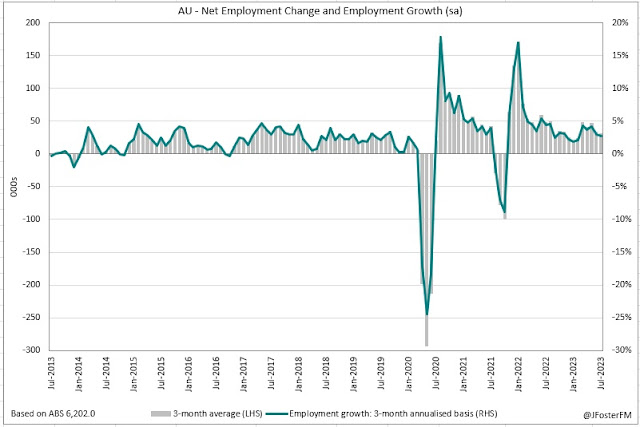Australia's Labour Force Survey for July was much weaker than expected across the major aspects of the report, going against the trend of recent outcomes. This looks to be attributable to seasonal volatility around the end of the financial year and school holidays. Today's report, together with an underwhelming rise in wages growth in the June quarter, appears consistent with the RBA remaining on pause.
The key details were:
- Employment declined by 14.6k (on net) in July, against expectations for a 15k rise and after a 31.6k gain in June (revised from 32.6k).
- The unemployment rate lifted from 3.5% to 3.7% (vs 3.6% expected) on the back of the fall in employment. The broader underemployment rate was unchanged at 6.4% while total underutilisation rose from 9.9% to 10.1%.
- Labour force participation declined from 66.8% to 66.7% but remains just off the record high in May (66.9%).
- Hours worked lifted by 0.2% in July and have increased by 5.2% over the year.
The tone of the July report was weak. As covered in my preview, I had suspected today's report may have been a repeat from 12 months ago, with seasonal volatility around the end of the financial year and school holidays impacting the data significantly. Today's release from the ABS made reference to these factors in its analysis. While only time will tell, the labour market remains strong and there looks to be no reason not to expect a rebound in August.
July's employment outcome (-14.6k) was the weakest going all the way back to the Delta wave lockdowns of the pandemic in 2021, and only the third monthly fall since then. Full-time employment (-24.2k) accounted for all of the decline, with part time employment rising (9.6k).
Incorporating the July outcome, employment gains have averaged a solid 31.1k over the past 3 months. At a 2.7% annualised rate, that broadly matches the rapid growth seen in the working-age population, suggesting post-pandemic migration has been a factor that has kept labour demand supported, despite slower economic growth.
With the labour force increasing by around 21k in the month and employment falling, unemployment increased by 35.6k in the month, explaining the uptick in the heads-based national unemployment rate from 3.5% to 3.7%. The participation rate was lower in July at 66.7%, though it's difficult to read much into this statistic given the timing of the survey.'Two broad perspectives on the labour market are that: 1) the share of Australians in work (measured by the employment to population ratio) remains around the highest levels on record, and 2) spare capacity in the labour market (measured by the underutilization rate) is at very low levels, though it has loosened slightly in recent months.
Hours worked ticked up by 0.2% in the month, softer than the 0.4% rise in June. The ABS noted the number of people on annual leave was lower than usual for this time of year; however, illness-related absences have picked up to elevated levels again this winter but are well down from the highs of the pandemic.






